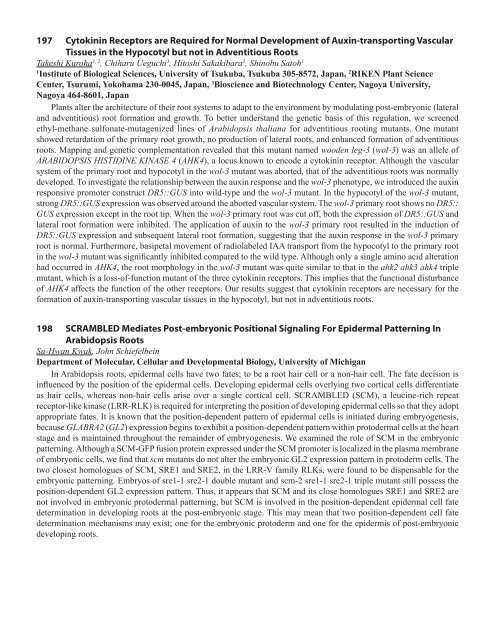75 Integrating Membrane Transport with Male Gametophyte ... - TAIR
75 Integrating Membrane Transport with Male Gametophyte ... - TAIR
75 Integrating Membrane Transport with Male Gametophyte ... - TAIR
Create successful ePaper yourself
Turn your PDF publications into a flip-book with our unique Google optimized e-Paper software.
197 Cytokinin Receptors are Required for Normal Development of Auxin-transporting Vascular<br />
Tissues in the Hypocotyl but not in Adventitious Roots<br />
Takeshi Kuroha 1, 2 , Chiharu Ueguchi 3 , Hitoshi Sakakibara 2 , Shinobu Satoh 1<br />
1<br />
Institute of Biological Sciences, University of Tsukuba, Tsukuba 305-8572, Japan, 2 RIKEN Plant Science<br />
Center, Tsurumi, Yokohama 230-0045, Japan, 3 Bioscience and Biotechnology Center, Nagoya University,<br />
Nagoya 464-8601, Japan<br />
Plants alter the architecture of their root systems to adapt to the environment by modulating post-embryonic (lateral<br />
and adventitious) root formation and growth. To better understand the genetic basis of this regulation, we screened<br />
ethyl-methane sulfonate-mutagenized lines of Arabidopsis thaliana for adventitious rooting mutants. One mutant<br />
showed retardation of the primary root growth, no production of lateral roots, and enhanced formation of adventitious<br />
roots. Mapping and genetic complementation revealed that this mutant named wooden leg-3 (wol-3) was an allele of<br />
ARABIDOPSIS HISTIDINE KINASE 4 (AHK4), a locus known to encode a cytokinin receptor. Although the vascular<br />
system of the primary root and hypocotyl in the wol-3 mutant was aborted, that of the adventitious roots was normally<br />
developed. To investigate the relationship between the auxin response and the wol-3 phenotype, we introduced the auxin<br />
responsive promoter construct DR5::GUS into wild-type and the wol-3 mutant. In the hypocotyl of the wol-3 mutant,<br />
strong DR5::GUS expression was observed around the aborted vascular system. The wol-3 primary root shows no DR5::<br />
GUS expression except in the root tip. When the wol-3 primary root was cut off, both the expression of DR5::GUS and<br />
lateral root formation were inhibited. The application of auxin to the wol-3 primary root resulted in the induction of<br />
DR5::GUS expression and subsequent lateral root formation, suggesting that the auxin response in the wol-3 primary<br />
root is normal. Furthermore, basipetal movement of radiolabeled IAA transport from the hypocotyl to the primary root<br />
in the wol-3 mutant was significantly inhibited compared to the wild type. Although only a single amino acid alteration<br />
had occurred in AHK4, the root morphology in the wol-3 mutant was quite similar to that in the ahk2 ahk3 ahk4 triple<br />
mutant, which is a loss-of-function mutant of the three cytokinin receptors. This implies that the functional disturbance<br />
of AHK4 affects the function of the other receptors. Our results suggest that cytokinin receptors are necessary for the<br />
formation of auxin-transporting vascular tissues in the hypocotyl, but not in adventitious roots.<br />
198 SCRAMBLED Mediates Post-embryonic Positional Signaling For Epidermal Patterning In<br />
Arabidopsis Roots<br />
Su-Hwan Kwak, John Schiefelbein<br />
Department of Molecular, Cellular and Developmental Biology, University of Michigan<br />
In Arabidopsis roots, epidermal cells have two fates; to be a root hair cell or a non-hair cell. The fate decision is<br />
influenced by the position of the epidermal cells. Developing epidermal cells overlying two cortical cells differentiate<br />
as hair cells, whereas non-hair cells arise over a single cortical cell. SCRAMBLED (SCM), a leucine-rich repeat<br />
receptor-like kinase (LRR-RLK) is required for interpreting the position of developing epidermal cells so that they adopt<br />
appropriate fates. It is known that the position-dependent pattern of epidermal cells is initiated during embryogenesis,<br />
because GLABRA2 (GL2) expression begins to exhibit a position-dependent pattern <strong>with</strong>in protodermal cells at the heart<br />
stage and is maintained throughout the remainder of embryogenesis. We examined the role of SCM in the embryonic<br />
patterning. Although a SCM-GFP fusion protein expressed under the SCM promoter is localized in the plasma membrane<br />
of embryonic cells, we find that scm mutants do not alter the embryonic GL2 expression pattern in protoderm cells. The<br />
two closest homologues of SCM, SRE1 and SRE2, in the LRR-V family RLKs, were found to be dispensable for the<br />
embryonic patterning. Embryos of sre1-1 sre2-1 double mutant and scm-2 sre1-1 sre2-1 triple mutant still possess the<br />
position-dependent GL2 expression pattern. Thus, it appears that SCM and its close homologues SRE1 and SRE2 are<br />
not involved in embryonic protodermal patterning, but SCM is involved in the position-dependent epidermal cell fate<br />
determination in developing roots at the post-embryonic stage. This may mean that two position-dependent cell fate<br />
determination mechanisms may exist; one for the embryonic protoderm and one for the epidermis of post-embryonic<br />
developing roots.





